The Business of Magic
Lucy Watson's Re-Present Me at Anthony Greaney
Anthony Greaney has stenciled a rune onto the glass door of his Harrison Avenue gallery (Boston), and he will tell you that it means "fantasy" though it looks like the logo for a baseball team, or an eerie greeting: "HI." Vela Phelan either recommended the rune, or put it there, and Greaney trusts him. Anthony Greaney is a trusting person.
Some such quality, at least, seems necessary courage for the owner of a commercial gallery who would take, as Greaney has, a step without local precedent toward opening doors and press avenues to a crop of young artists operating on the outside fringes of the art-world's commercial matrix. Some among these artists are somewhat more likely to make a mess than a profit, which is not a reproach: it's even possible that the economic objective of the work (as performance versus object-making) could be defined along those terms.
If it is the case that Greaney is not searching for an underground practice with commodifiable futures (in the mold of Tiny Creatures and other relics of the prosperous nineties), he has performed a gesture of patronage and accumulation in the most important sense. There is a rune on the door: in the Harrison Avenue cultural mini-mall that opens itself hopefully in the general direction of money and influence, the artists who colonize Greaney's space dash off sloppy missives of destabilizing paradigm. Like most signifiers of counterculture, it is actually magic.
Lucy Watson is a mystic. Though her own performance comes last in this little account as basic chronology suggests, her curatorial gesture marks the opening and should be touched upon. "Performance art is an inherently feminist medium," Watson wrote (in an essay on Re: Present Me that previewed the event from some more Alexis Avedisian's v-e-l-l-u-m platform), "the anonymous muse is often an undocumented performer–and many critical female artists are just now receiving written recognition for their art-world contributions." The ongoing association between performance art and queer and feminist intellectual scenes is one that strikes us as twentieth-century tradition: Watson's essay requires no prior knowledge of the specific work that it introduces, so easily does it lie with a body of contemporary discourse.
Thus you will notice, as I continue, a deliberate use of pronouns that reflects the identity politics of the artists. But let me be clear: the night's performances didn't just follow a map drawn from the parcel of theory, and commentary only within that critical framework would be useless. Important it is that the artists are capable of pushing on even their own ideologies, and breaking theoretical structures into some other kind of expression. The cerebral scaffolding burned to the ground. It should.
Theater people are accustomed to orchestrated tempos that delineate performance. We like to begin with a blackout, a curtain speech where everybody gets thanked, a few polite rounds of silence and applause, a light cue, and, maybe, a rising velvet curtain, all to frame whatever emotional action it is we do onstage.
The first artist to perform at Re-Present Me, Madge of Honor, walks out naked, into an unassembled chatting crowd of audience under full fluorescents, to face a mirror mounted on the wall and, above it, a brass bell out of reach. The tempo, without frame, is entirely up to them. An expected development: the artist jumps for the bell. They cannot quite reach it and the gallery becomes a drum, pounded with failure at each jump's landing. We watch the bell, silent and expectant. Her fingers keep brushing it, but it doesn't ring. As in any durational work that turns on failure, there is a Beckettian element: as the artist jumps, we sometimes brush off the time spent as unsuccessful, anticipating the goal as if we were watching a sporting event where the feat is all that matters. But other ways of seeing float in.
Madge of Honor's body, framed by the mirror, traces its own baroque image on a gallery wall. The incredible shapes of strain and recovery are as compositional as sensuous, while the reference to athletics shapes the way we watch the body over time. Though the gesture is repetitive, and never commented upon, the way of seeing the body's motion changes rapidly, inviting projected thought-structures for the visual sense.
These make the work conceptually complex, and are only the stranger when the artist's sweat has so coated the floor that they risk a fall at each landing: Madge of Honor, who does not wish to be referred to with gendered pronouns, rises with blood dripping down their leg, and the enterprise becomes perverse. Should injury, too, be treated as an ephemeral image for viewer's pleasure? Is she going to keep going? And over all these the constant ache for success, get it, get it, ring the bell! By the time the bell rings, and the artist, out of breath, walks exhausted from the space, everyone is applauding—organically, and not according to a rote convention. But this kind of question, under the hum of anticipation, has an open end.
Maria Molteni brushes such questions of visual pleasure, performing as an entr'acte to the other pieces her Afterswarm. At her first appearance, she is a striking contrapuntal to Madge of Honor. Molteni is still. She wears a sequined dress and stands in an arranged lighting, voguing a feminine posture that might have come out of a 1941 Vanity Fair, and lets her shadow touch the wall. Stillness is exacting. What to make of this?
Molteni's performance is almost a private act: she has stung herself with 36 worker bees, and various parts of her body are puffed with the venom. The still and presentational effect is not a sham, but it is a performance of blank presence and composure, like some ideals of the feminine: bringing pain, and her own artist's agency, completely into the interior, Molteni's anti-performance is unsettlingly visual. We have nothing to do but look at her, she is effectively turning herself into sculpture, though the work she is actually doing might be describable in a flurry of critical terms. Here is a section of the brief account, which she later emailed me privately:
my piece is positioned as an inverse or post-incident representation of a historic honeybee bearding of the body. . . Initiating a transferal of substances in attempt to fuse the energy of a colony with my own. . . sexualization of the body compares to the practice of art modeling and overt sexual ambiguity of honeybees and their "keepers" (Queen's function as both ovaries and testes of a super organism, Her duality between pampered matriarch and colony's sex slave, bee-bearded ladies, and the idea of a beekeeper more appropriately termed observer name a few paradigms)
Discomfort from the stings made Molteni twitch and grimace slightly, but the veneer was nearly perfect. It occurred to me while watching that there was a weird perversity, even on par with Madge of Honor, to the act of confining the artist's process exclusively to private meditation while presenting the self to be admired as an object in the visual field. It occurred to me, too, that this kind of perverse self-containment is one of the classic performances of femininity.
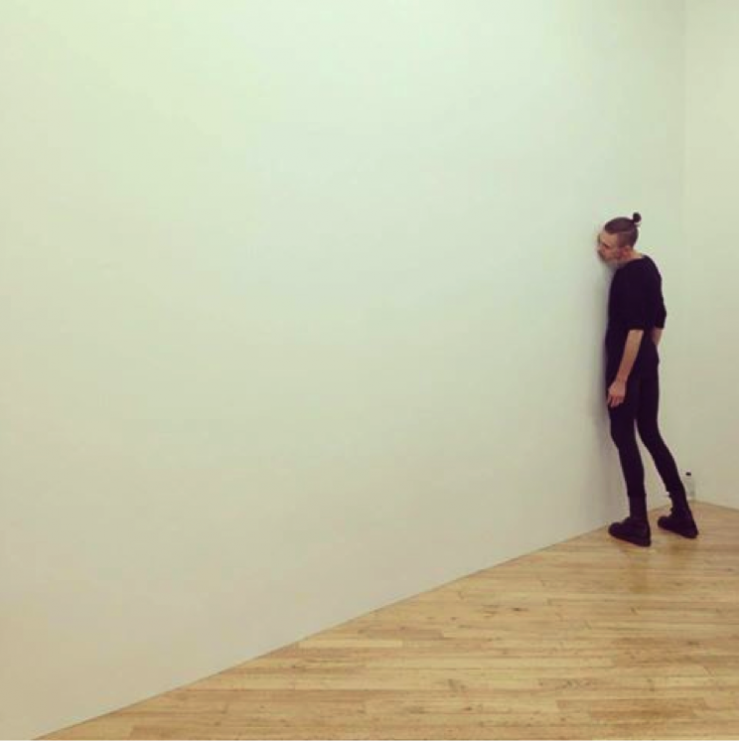
Vanouse.
Another is romantic hysteria. Creighton Baxter displayed a long letter, handwritten on white sheets of fondant that looked like paper, below a drawing based on documentation from an earlier performance. She paced the room, and dragged her face across it. It left a soft cosmetic streak and the abrasion rouged her cheeks. Baxter works with a remarkable focus laminating a structured performance of three distinct parts.
After this first action with her face and the wall, she takes the letter from the wall and disassembles sugar paper with long fingers, peeling it from the plastic backing, rolling it into balls, slowly and pensively swallowing, regurgitating grayish slime to lick the crumbs from the floor. It is all done very neatly, with peculiar calm.
Watson’s response to centuries of oppression is not drily theoretical, not politically incensed, but imaginative and practical: in the role of a “muse,” one does not come through, and she would like everybody to know it honestly.
The last action is speech. Pacing a corner, box-stepping, Baxter begins to murmur, then whisper, then speak, then shout at the top of her lungs to points beyond strain. Is she saying cry or Craig? Emotion obscures sense. She takes the drawing from the wall. It is the end.
Watson's own performance is hallucinatory and cacophonic. She asks for volunteer "candy girls" and has them ring bells. She projects video of herself talking at photobooth about supernatural experiences. There is a song performed by a puppet version of Lucy with a clay head. And she does a funny little skit about going to work at an art museum, stopping somebody (it is Nico Alba) from touching the art.
This is all done with a crazed tongue in a crazed cheek: it is more an acid trip about the little plotline I've just described than anything recognizable, and it quickly devolves as Alba and Watson grapple (I mean physically) over the problem of touching the art, ripping each other's clothes off (they're sort of dressed underneath, in something like metallic wrapping paper) and donning matching triangular headpieces. More videos about Watson's mystic experience. More bells and toy piano sounds by the candy girls. Lucy brings somebody behind an upturned table and does something with him I can't see. Nico is naked now, and ranging through the audience giving kisses and having people take her photo in cheesecake poses with a huge old camera, then making a bed on the floor, arranging crystals, photos, other effects.
Lucy is trying to smash the clay head with a stick, which breaks, and something from the sculpture slices her face. "I thought I could break this," she tells us, grinning while the blood rolls down her face, "but I couldn't."
All of this resolves itself in a plainspoken statement of the mystical experience that by this point has a slim place, if any, in the critical discourses that Watson's practice might seem to engage, from her statement on v-e-l-l-u-m. She engages them, truly, while she glancingly shoves them out of the way to get at something else entirely, which if it doesn't necessarily explain the cacophony, explains why it works just as well as anything else. "I believe in telepathy," she says, "and something like rubbing my blood on this piece of glass," ("Orange calcite," says Alba) "or, orange calcite expresses who I am better than these pieces that are supposed to be representations of me."
Theory isn't as important, in this scheme, as bodies, blood, or immediacy. The framework laid out in Watson's essay, rife with conceptual scaffold, becomes important in performance only to the extent that it echoes and testifies to a personal cosmology where physical representation must always fall short of a spiritual world described as "underneath everything," and, importantly, accessible.
Watson draws a blueprint for new gender politics (where biology does not determine the person's gendered identity) into a system of magical experience. What might look like art-world mumbo jumbo becomes strikingly honest and indistinguishable from ceremony—the way colors are indistinguishable in iridescent cloth. There is a conceptual frame, but it is partly built from structures of salvation and belief.
Watson’s response to centuries of oppression is not drily theoretical, not politically incensed, but imaginative and practical: in the role of a “muse,” one does not come through, and she would like everybody to know it honestly. Though her face bled as the night concluded, Watson has no truck with tragedy. The heaviness of speaking about oppression disappears. Ecstasy ignores its limits, seeking freedom.
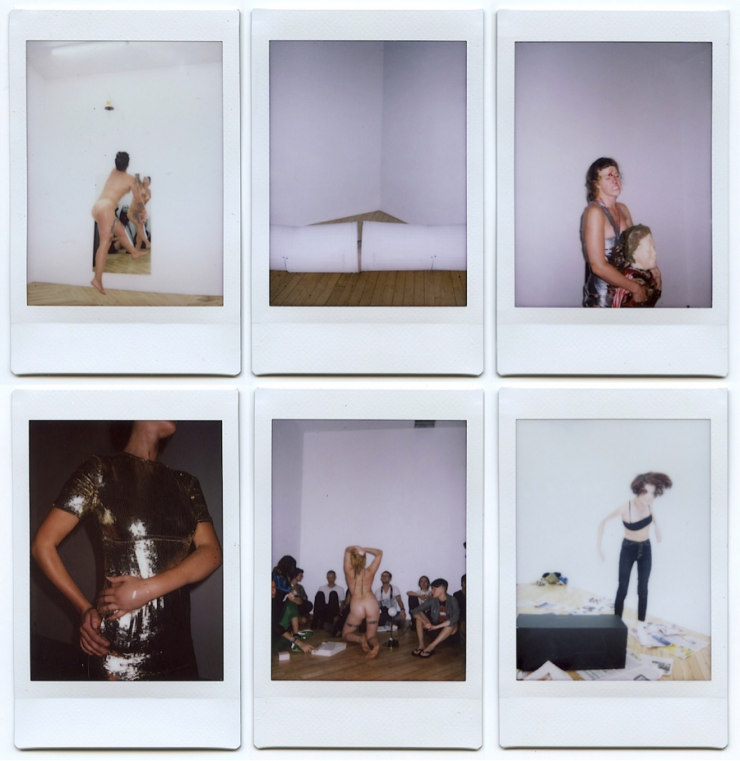
Imagery by DEAD ART STAR.
Photo by Alexis Avedisian of Creighton Baxter.
Imagery: DEAD ART STAR


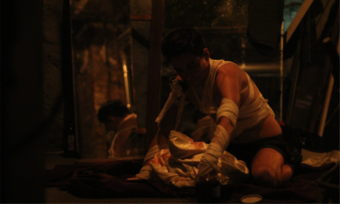

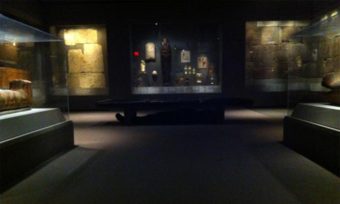
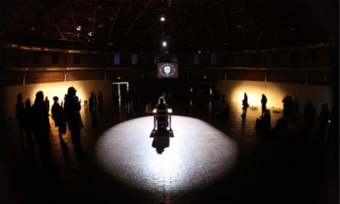
Comments
The article is just the start of the conversation—we want to know what you think about this subject, too! HowlRound is a space for knowledge-sharing, and we welcome spirited, thoughtful, and on-topic dialogue. Find our full comments policy here
Crying out......".....I thought I could break this......but I couldn't" brought tears to my eyes. The proverbial carrot dangling before us, Though it does make me wonder, is it not within ourselves that we ring the bell that is true and right?